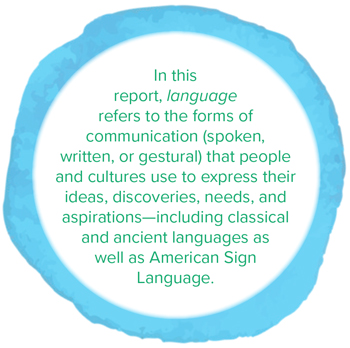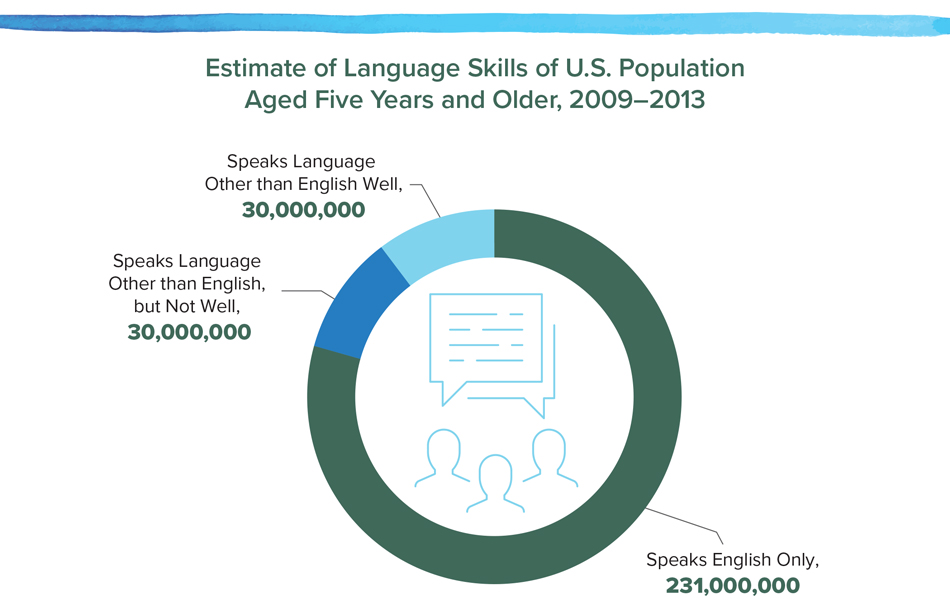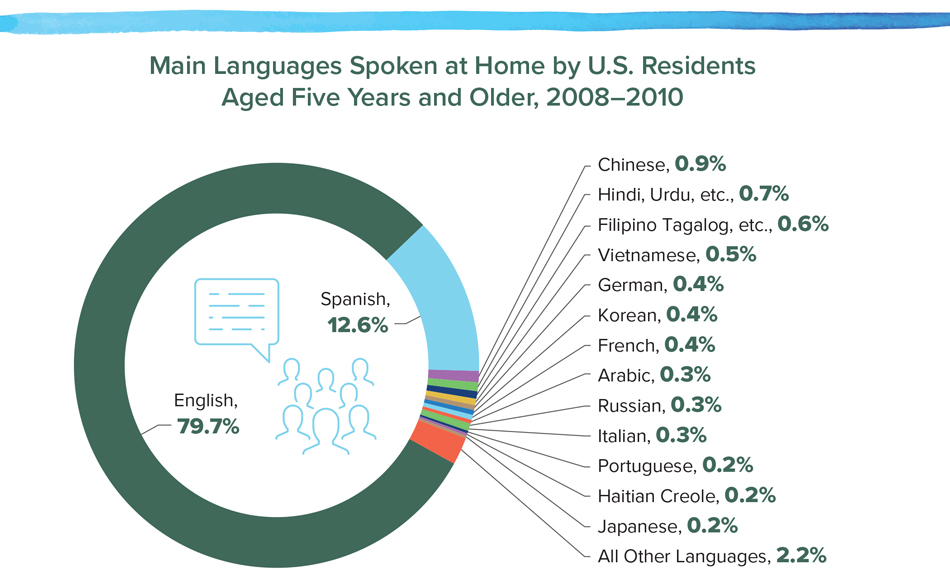Introduction
Through much of our recent history, the United States has had an inconsistent and paradoxical approach to language learning.4
We are a proudly multicultural, polyglot nation, home to more than 350 languages. Yet we continually ignore opportunities to value, nurture, and sustain languages other than English—opportunities that would greatly enhance our personal, cultural, professional, and civic lives, as well as the economic strength and security of our nation.
The United States has both driven and benefited from the spread of English globally. It is the most commonly taught language in the world by a factor of twenty. It is spoken in at least 101 countries and is a critical component of our commercial and diplomatic leadership.5 It is an official language of the United Nations, the World Trade Organization, the International Criminal Court, NATO, and the European Union. In short, the English language is a resource to be cherished and should continue to be an educational priority.

However, the dominance of English, to the exclusion of other languages, has also had adverse and often unforeseen consequences at home and abroad—in business and diplomacy, in civic life, and in the exchange of ideas. We often find ourselves left out of important conversations, misinterpreting what we hear, and failing to understand all-important nuances, precisely because we have undervalued languages other than English in our schools, our communities, and our own homes.
According to the U.S. Census Bureau, more than sixty-five million U.S. residents speak a language other than English at home—a number that has been growing decade by decade since the 1970s. Nevertheless, that number represents only 20.7 percent of the total population, and only a fraction of this cohort speaks, reads, and comprehends a second language well.6 The vast majority of American citizens remain monolingual.
Increasingly, policy-makers and business leaders are seeking to address the real costs associated with our nation’s limited capacity in languages. For example:
- For business: Almost 30 percent of the U.S. business executives who participated in a 2014 Coalition for International Education commissioned study reported missed opportunities abroad due to a lack of on-staff language skills, and nearly 40 percent reported that they had failed to reach their international potential due to language barriers.7 Business leaders are beginning to recognize that they are missing opportunities at home as well, especially in negotiations to attract foreign direct investment in the U.S. workforce, nearly 70 percent of which was channeled to the manufacturing sector in 2015.8 Several U.S. cities associated with the Brookings Institution’s Global Cities Initiative are now examining the strategic value of local language capacities in attracting such investment, and researchers are now finding evidence that businesses across the country will offer higher salaries to bilingual employees.9
- For science and technology: Language barriers impede the progress of science just as they impede business interactions. In one of the more startling recent examples, U.S. and other English-speaking scientists were late in recognizing the severity of the 2004 avian flu epidemic because the initial research on the disease was published in Chinese-language journals.10 In 2007, when Congress passed the America COMPETES Act to promote innovation in U.S. science and technology, it prioritized the need to increase “the opportunities to study critical foreign languages and the context in which the critical foreign languages are spoken; and . . . the number of American students who achieve the highest level of proficiency in critical foreign languages.”11 This commitment was, in part, a recognition that the nation’s competitiveness in scientific and technological innovation would be improved if researchers were able to communicate and translate their findings internationally and to account for the work of scientists who reported their findings in non-English journals.12
- For national security and international relations: In recent years, Congress and the Office of Management and Budget have held a series of hearings and issued several reports supporting the notion that the nation’s language deficit has threatened priorities in national security, diplomacy, and economic competitiveness. In 2012, the U.S. Department of State increased the number of “language-designated positions” by 15 percent to help build and maintain “an effective civilian workforce that can fulfill its role in strengthening the security and prosperity of our Nation.”14 At the same time, the Department of Defense requested that the nation’s school systems train more language speakers at an earlier age, in part because it has now created over thirty thousand positions that have a language requirement.15 And the Federal Bureau of Investigations, in response to the 9/11 attacks, increased the number of language experts on staff by 85 percent, a significant investment that still may not meet its current needs.16 The message in each case was clear: effective communication is the basis of international cooperation, and a strong national defense depends on our ability to understand our adversaries as well as our friends.17
An expanded capacity in world languages is also a social imperative, and the provision of language access in the delivery of social services is mandated under Title IV of the Civil Rights Act of 1964 and the Affordable Care Act.18 Growing numbers of American citizens speak languages other than English, and in some major urban areas, as many as half of all residents speak a non-English language at home.19 But all too often, their access to vital services, including health care, and even their ability to exercise simple rights are limited not only by their inability to communicate in English, but by the inability of service providers to communicate, or to secure the services of those who can communicate, in languages other than English.20 For example, recent reports suggest that language barriers (including the scarcity of interpreters and the absence of forms and information in languages other than English) are a particular obstacle to due process in state and federal courts.21 We have an obligation to do better, by educating a pool of experts who read, write, and speak a wide range of languages, and by deploying them where they are needed most.

Source: The estimate of the share of the total population that speaks a non-English language at home is based on the American Community Survey. See U.S. Census Bureau, “Detailed Languages Spoken at Home and Ability to Speak English for the Population 5 Years and Over for United States: 2009–2013,” American Community Survey, October 2015, http://www.census.gov/data/tables/2013/demo/2009-2013-lang-tables.html. Estimate of skill levels of adults eighteen and older drawn from Tom W. Smith, Peter Marsden, Michael Hout, and Jibum Kim, General Social Surveys, 1972–2014 [machine-readable data file] (Chicago: National Opinion Research Center at the University of Chicago, 2016), http://gssdataexplorer.norc.org.
Although there are many challenges ahead, there are reasons to believe that the United States can overcome its language deficit. Linguistic diversity is deeply embedded in our history. The English we speak is only one of many European, Native American, African, and Asian languages that have been spoken on the North American continent.22 This diversity is a cherished part of our nation’s past, a fact of our present, and a key to our future: a valuable asset in our relations with other nations and cultures and a benefit to our children as they grow up in an interconnected world. As the home of at least 350 languages in addition to English, we have a strong linguistic base and an unprecedented opportunity to engage other nations and cultures in ways that build lasting, mutually beneficial connections.23

Source: American Community Survey, 2008–2010 merged files, as quoted in Rubén G. Rumbaut and Douglas S. Massey, “Immigration and Language Diversity in the United States,” Dædalus 142 (3) (Summer 2013): 146.
Tapping this vast potential would have real benefits for our personal lives as well as for commerce, security, and diplomacy. Researchers are discovering that language learning, particularly among young children, improves learning outcomes in a variety of other disciplines over a long period of time.24 New empirical evidence suggests that it also encourages the development of empathy and effective interpretive skills.25 Bilingualism enhances overall cognitive ability among the young and old alike, and may even help delay certain manifestations of aging.27 And anyone who has traveled abroad, conversed with a citizen from a different country, or communicated with a speaker of a different language in this country can attest to the ways in which language competency enriches life experiences and provides new opportunities for personal growth.
For all of these reasons, there is an emerging consensus among leaders in education and science, business and government, international relations and the military, and community organizations and nonprofits that English is critical but not sufficient to meet the nation’s future needs, and that a greater public emphasis on language education would yield results far greater than any initial financial investments.28 In the pages that follow—the product of discussion and deliberation over eighteen months—the American Academy’s Commission on Language Learning offers its findings and recommendations to improve the nation’s language capacity. This report focuses on five basic goals:
- Increase the number of language teachers at all levels of education so that every child in every state has the opportunity to learn a language other than English.
- Supplement language instruction across the education system through public-private partnerships among schools, government, philanthropies, businesses, and local community members.
- Support heritage languages already spoken in the United States, and help these languages persist from one generation to the next.
- Provide targeted programming and additional support for Native American languages being used as primary languages of education.
- Promote opportunities for students of all ages to learn languages by experiencing other cultures and immersing themselves in languages as they are used in everyday interactions and across all segments of society.
In combination, these goals outline a strategy to improve language education so that every individual, as well as the nation as a whole, can share in the rewards and benefits of learning a language other than English. Schools, two- and four-year colleges, universities, community organizations, businesses, government agencies, philanthropists, students, and parents all have a role to play in advancing these goals. It is critical that we work together at this moment in history, when there is so much to gain by participating in a multilingual world, and so much to lose if we remain stubbornly monolingual.

Trevor Gunn, Ph.D.
Vice President, International Relations, Medtronic, Inc.
Trevor Gunn is vice president of international relations for Medtronic, Inc., the world’s largest medical technology company. He learned French in school and during trips to visit family in France, and Swedish as an exchange student while in high school. Gunn also took several college courses in Russian and became proficient as a result of his business interactions.
Gunn was formerly the long-time director of the Commerce Department’s Business Information Service for the Newly Independent States (BISNIS), the clearinghouse for U.S. government information for doing business in the former Soviet Union. For twenty-two years, he has been an Adjunct Professor at CERES in Georgetown University’s Walsh School of Foreign Service.
In his career, Gunn has worked with the Chamber of Commerce of Southern Sweden, Dover Elevator Corporation (now ThyssenKrupp of Germany), International Executive Service Corps, and on the staffs of the former San Francisco mayor and two U.S. senators from California. He received his bachelor’s degree from the University of San Francisco and his Ph.D. in international relations from the London School of Economics.
“Through the eight languages I tried and the three languages in which I developed proficiency, the accumulated knowledge has allowed me to weave in and out of various countries professionally and with confidence. Knowing other languages has made me a significantly better negotiator and business partner, and contributed immensely to my professional growth and chosen path. Command of a foreign language puts you in charge of your future.”13

James Tobyne
Strategic Partnerships & Business Development, Alibaba.com
James Tobyne holds a bachelor’s degree from Marquette University and a master of science in foreign service from Georgetown University. He was a Freeman Asia Scholar in Beijing and a U.S. Department of State Critical Language Scholar in Suzhou, in addition to completing language and cultural studies in Milwaukee and Taipei. Proficient in Mandarin Chinese, Tobyne is dedicated to promoting international trade, economic development, and cross-cultural communication. He has traveled professionally throughout the United States, Asia, and South America, working for organizations such as the US-ASEAN Business Council, Al Jazeera English, and Export Now. Before joining the e-commerce company Alibaba Group, he served as a Global Project Fellow for the D.C.-based Bertelsmann Foundation and an advisor and field researcher in Ulaanbaatar, Mongolia, for the Millennium Challenge Corporation.
“When I was in high school, I thought learning a foreign language was a complete waste of time and effort. Today, as an employee of one of the world’s largest Internet companies, my language skills—including proficiency in Mandarin Chinese—are an essential component of my job.”26
One Vision for the Future
The 2013 Languages for All initiative, organized by the University of Maryland Center for Advanced Study of Language in collaboration with several national and international language associations, has outlined reasonable attainment goals for the nation’s future language learners.
This vision of the future of language includes:
- 100 percent of learners in the U.S. education system exposed to international perspectives, cultures, and/or languages in order to inform life-long decisions about work and learning, and to support language and international efforts broadly in society. Of that group:
- 30 percent of learners will acquire basic language skills in order to work, for example, in the service industry and to travel freely;
- 15 percent of learners will acquire the global professional skills needed to practice at a high level internationally; and
- 5 percent will acquire expert skills in order to perform necessary research and to engage in international diplomacy.
Source: Languages for All? (College Park: University of Maryland Center for Advanced Study of Language, 2013), accessible at http://www.americancouncils.org/sites/default/files/LFA2013_FinalReport.pdf.
ENDNOTES
4. See, for example, Brian T. Edwards, “Teach Arabic in Public Schools,” Chicago Tribune, April 6, 2015, http://www.chicagotribune.com/news/opinion/commentary/ct-arabic-language-public-schools-perspec-0406-20150403-story.html.
5. Rick Noack and Lazaro Gamio, “The World’s Languages, in 7 Maps and Charts,” The Washington Post, April 23, 2015, https://www.washingtonpost.com/news/worldviews/wp/2015/04/23/the-worlds-languages-in-7-maps-and-charts/.
6. U.S. Census Bureau, “Detailed Languages Spoken at Home and Ability to Speak English for the Population 5 Years and Over for United States: 2009–2013.”
7. “2014 U.S. Business Needs for Employees with International Expertise,” Shirley J. Daniel and Fujiao Xie, Center for International Business Education and Research at University of Hawai’i at Manoa, and Ben L. Kedia, Center for International Business Education and Research at the University of Memphis. A collaboration of the Coalition for International Education and the Association for International Business Education and Research for Internationalization of U.S. Education in the 21st Century, April 2014, William & Mary, Williamsburg, VA. http://www.wm.edu/offices/revescenter/globalengagement/internationalization/papers%20and%20presentations/danielkediafull.pdf
8. Office of Public Affairs, U.S. Department of Commerce, “U.S. Commerce Department Releases New Report on Foreign Direct Investment Trends,” press release, June 20, 2016, https://www.commerce.gov/news/press-releases/2016/06/us-commerce-department-releases-new-report-foreign-direct-investment; and Joint National Committee for Languages, The Contributions of Language to the Economic Interests of the United States (Cambridge, Mass.: American Academy of Arts and Sciences, 2015), https://www.amacad.org/multimedia/pdfs/TheContributionsofLanguagetotheEconomicInterestsoftheUnitedStates.pdf.
9. Global Cities Initiative, Metro Atlanta: Foreign Direct Investment Plan (Washington, D.C.: Brookings Institution and J. P. Morgan Chase, 2016), http://www.atlantafdiportal.com/wp-content/uploads/2016/05/16-57-FDI-FINAL_WEB-2.pdf; and Rebecca M. Callahan and Patricia C. Gándara, eds., The Bilingual Advantage: Language, Literacy and the U.S. Labor Market (Bristol, United Kingdom: Multilingual Matters, 2014), 178.
10. David Cyranoski, “Bird Flu Data Languish in Chinese Journals: Health Authorities in the Dark as Warnings Go Untranslated,” Nature 430 (955) (August 2004), http://www.nature.com/nature/journal/v430/n7003/full/430955a.html.
11. U.S. Congress, America COMPETES Act, August 9, 2007, 110th Congress, Public Law 110-69, 94, https://www.congress.gov/110/plaws/publ69/PLAW-110publ69.pdf.
12. Ibid.
13. Email exchange with the Commission on Language Learning, January 2017.
14. U.S. Senate, Committee on Homeland Security and Governmental Affairs, A National Security Crisis: Foreign Language Capabilities in the Federal Government, 112th Congress, 2nd Sess., May 21, 2012, S. Hrg. 112-663, 9, http://www.gpo.gov/fdsys/pkg/CHRG-112shrg75214/pdf/CHRG-112shrg75214.pdf.
15. Laura J. Junor, “A National Security Crisis: Foreign Language Capabilities in the Federal Government,” statement before the Committee on Homeland Security and Governmental Affairs, Subcommittee on Oversight of Government Management, Federal Workforce, and the District of Columbia, United States Senate, May 21, 2012, 3.
16. U.S. Senate, Committee on Homeland Security and Governmental Affairs, A National Security Crisis: Foreign Language Capabilities in the Federal Government.
17. For more information on languages and national security, see Gail H. McGinn, Foreign Language, Cultural Diplomacy, and Global Security (Cambridge, Mass.: American Academy of Arts and Sciences, 2015), https://www.amacad.org/multimedia/pdfs/Foreign-language-Cultural-Diplomacy-Global-Security.pdf.
18. Executive Order 13166 of August 11, 2000, “Improving Access to Services for Persons with Limited English Proficiency,” Code of Federal Regulations, Title 3 (Washington, D.C.: U.S. Government Publishing Office, 2001), 289–291.
19. See Camille Ryan, Language Use in the United States: 2011, American Community Survey Reports (Washington, D.C.: U.S. Census Bureau, August 2013), http://www.census.gov/prod/2013pubs/acs-22.pdf; Executive Order 13166 of August 11, 2000; and U.S. Congress, Patient Protection and Affordable Care Act, March 23, 2010, 111th Congress, 2nd Sess., H.R. 3590.
20. Terrence Wiley, Beatriz Arias, Jennifer Renn, and Shereen Bhalla, Language and the Fulfillment of the Potential of All Americans (Cambridge, Mass.: American Academy of Arts and Sciences and the Center for Applied Linguistics, 2015), 20, https://www.amacad.org/multimedia/pdfs/CAL-AAASWhitePaper-LanguagePotentialAmericans.pdf.
21. Laura K. Abel, Language Access in the Federal Courts (New York: National Center for Access to Justice at Cardozo School of Law, 2013), http://ncforaj.org/wp-content/uploads/2013/12/abel-ncaj-language-access-federal-courts.pdf.
22. Rubén G. Rumbaut and Douglas S. Massey, “Immigration & Language Diversity in the United States,” Dædalus 142 (3) (Summer 2013): 141.
23. U.S. Census Bureau, “Census Bureau Reports at Least 350 Languages Spoken in U.S. Homes,” press release CB15-185, November 3, 2015, http://www.census.gov/newsroom/press-releases/2015/cb15-185.html.
24. Penelope W. Armstrong and Jerry D. Rogers, “Basic Skills Revisited: The Effects of Foreign Language Instruction on Reading, Math, and Language Arts,” Learning Languages 2 (3) (1997): 20–31.
25. Samantha A. Fan, Zoe Liberman, Boaz Keysar, et al., “The Exposure Advantage: Early Exposure to Multilingual Environment Promotes Effective Communication,” Psychological Science 26 (7) (2015), http://pss.sagepub.com/content/early/2015/05/08/0956797615574699.abstract.
26. Email exchange with the Commission on Language Learning, November 2016.
27. Clara Moskowitz, “Learning a Second Language Protects Against Alzheimer’s,” Live Science, February 18, 2011, http://www.livescience.com/12917-learning-language-bilingual-protects-alzheimers.html.
28. Richard D. Brecht, America’s Languages: Challenges and Promise (Cambridge, Mass.: American Academy of Arts and Sciences, 2015), https://www.amacad.org/multimedia/pdfs/AmericasLanguagesChallengesandPromise.pdf.
